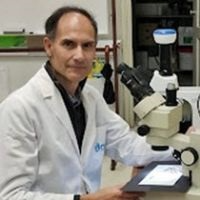Smart Microalgal Biotechnology
A special issue of Water (ISSN 2073-4441). This special issue belongs to the section "Water-Energy Nexus".
Deadline for manuscript submissions: closed (25 December 2023) | Viewed by 10361
Special Issue Editors
Interests: biodiesel of microalgae; bioethanol; biohydrogen; biotechnology of pharmaceutical products; microalgae and cancer treatment; microalgae and antioxidants; wastewater bioremdiation
Interests: marine biotechnology; phycology; biodiversity; nutraceuticals
Special Issues, Collections and Topics in MDPI journals
Special Issue Information
Dear Colleagues,
Microalgae have become important in the field of biotechnology. Microalgal biotechnology includes several techniques for producing many different bioproducts, such as food supplements, nutraceuticals, pharmaceuticals, biofuels, and agricultural or industrial biochemicals. Nowadays, it is used in the production of bioplastics, biostimulants, and biopesticides. Microalgal biotechnology has gained attention in the bioremediation of industrial, agricultural, and domestic wastewater. Microalgae biotechnology has several advantages since microalgae can be cultivated in severe conditions and use wastewater as well as saline water. Recent research activities in microalgal biotechnology are expanding to comprise different areas of industry, agriculture, and health. The present Thematic Topic on “Smart Microalgal Biotechnology” aims to gather original research works and reviews and to integrate the current progress and recent research advances of basic and applied aspects of microalgal biotechnology.
We welcome submissions that cover, but are not limited to, the following topics:
- Microalgae cultivation and biomass production for food and feed;
- Microalgae for wastewater treatment;
- Cultivation of algae in wastewater and recycling;
- Coupling microalgae bioremediation of wastewater and bioenergy;
- Cultivation of microalgae to produce valuable products such as nutraceuticals, pharmaceuticals, bioplastics, biostimulants, etc.;
- Microalgal biotechnology for biofertilizer production;
- Microalgal biotechnology for minimizing global changes and reduction in greenhouse gas emission;
- Algae for CO2 sequestration into biomass for valuable products.
Prof. Dr. Mostafa M. El-Sheekh
Prof. Dr. Leonel Pereira
Guest Editors
Manuscript Submission Information
Manuscripts should be submitted online at www.mdpi.com by registering and logging in to this website. Once you are registered, click here to go to the submission form. Manuscripts can be submitted until the deadline. All submissions that pass pre-check are peer-reviewed. Accepted papers will be published continuously in the journal (as soon as accepted) and will be listed together on the special issue website. Research articles, review articles as well as short communications are invited. For planned papers, a title and short abstract (about 100 words) can be sent to the Editorial Office for announcement on this website.
Submitted manuscripts should not have been published previously, nor be under consideration for publication elsewhere (except conference proceedings papers). All manuscripts are thoroughly refereed through a single-blind peer-review process. A guide for authors and other relevant information for submission of manuscripts is available on the Instructions for Authors page. Water is an international peer-reviewed open access semimonthly journal published by MDPI.
Please visit the Instructions for Authors page before submitting a manuscript. The Article Processing Charge (APC) for publication in this open access journal is 2600 CHF (Swiss Francs). Submitted papers should be well formatted and use good English. Authors may use MDPI's English editing service prior to publication or during author revisions.
Keywords
- wastewater bioremediation
- microalgae biodiesel
- microalgae
- water quality






